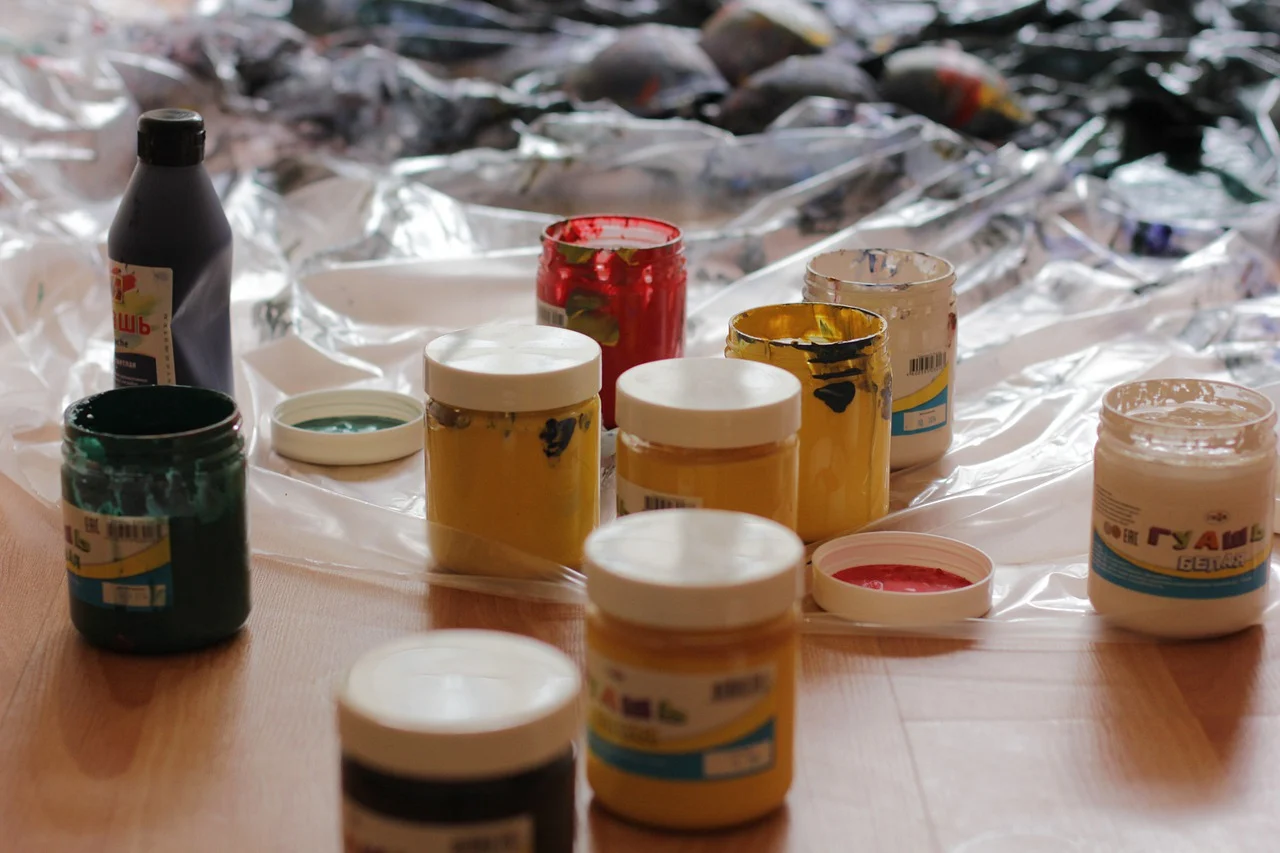Fluorescent paint is vibrant and eye-catching. It’s widely used in art, DIY projects, and industries. Thinning it is often necessary for the right consistency and effect. But what happens when you thin fluorescent paint, and how does it impact the final results? This post covers the science of fluorescent paint and tips for thinning it effectively.
What Is Fluorescent Paint?
Fluorescent paint contains pigments that glow by absorbing UV light and re-emitting it as visible light. This gives it a glowing effect. It’s perfect for neon signs, art, safety markings, and props. However, its thick consistency and high pigmentation can be hard to handle directly.
Why Would You Thin Fluorescent Paint?
Thinning fluorescent paint can be essential for achieving specific artistic or practical effects. Here are the main reasons why you might want to thin fluorescent paint:
Improved Flow and Application
Fluorescent paint often has a thick consistency, which can make it difficult to apply smoothly. Thinning the paint allows for better flow, reducing brush strokes and creating an even finish.
Compatibility with Spray Guns
If you’re using a spray gun or airbrush, thinning the paint is necessary to achieve the proper consistency. Thin paint flows smoothly through the nozzle, ensuring an even spray and reducing clogs.
Creating Transparent Layers
Thinning is ideal when you want to create transparent layers for artistic effects, such as glazing or soft transitions. This technique is especially useful in layering colors to build depth and vibrancy.
Special Effects and Textures
Adjusting fluorescent paint’s thickness allows for unique effects. You can create washes, drips, or fine details. These are harder to achieve with thicker paint.
Stretching the Paint
Thinning the paint helps it last longer. It’s useful for covering large surfaces or multiple projects. This saves product and reduces waste.
Thinning fluorescent paint enhances its versatility. It allows you to tailor the paint to your needs.
What Happens Chemically When You Thin Fluorescent Paint?
Thinning fluorescent paint changes its composition. This impacts its performance and appearance. Here’s what happens chemically:
Pigment Dilution
Thinning the paint reduces the concentration of fluorescent pigments suspended in the medium. These pigments are responsible for the paint’s glowing effect under UV light. As they become more diluted, the intensity of the glow and overall brightness may diminish.
Binder Interaction
Fluorescent paint contains a binder, often acrylic or solvent-based, which holds the pigments together and adheres them to surfaces. Adding a thinner weakens this binder. If too much thinner is used, the paint may lose its ability to stick effectively, leading to cracking, peeling, or a fragile finish.
Viscosity Change
Thinners decrease the paint’s viscosity (thickness), allowing it to flow more freely. While this improves application, the lower viscosity can cause the paint to spread unevenly or drip, especially on vertical surfaces.
Drying Time Adjustments
Different thinners affect drying times in various ways. For example:
- Water (in acrylic paints) often extends drying time slightly.
- Solvents like mineral spirits or turpentine accelerate evaporation, resulting in faster drying.
Transparency Increase
Thinning the paint makes it more transparent because there are fewer pigments per unit of volume. This can be useful for creating layers or washes but may reduce opacity when a solid color is desired.
Separation Risks
Incompatible thinners or improper mixing can cause the paint’s components to separate. Pigments may settle, or the binder might break down, leading to uneven application and an unpredictable finish.
By understanding these chemical changes, you can thin fluorescent paint appropriately to achieve your desired effect without compromising its quality.
Thinning Fluorescent Paint: Key Considerations
Thinning fluorescent paint requires careful attention to detail to ensure the final result meets your expectations. Keep these key points in mind:
Type of Paint
The base type of fluorescent paint—acrylic, solvent-based, or oil-based—determines the appropriate thinner to use. Using the wrong thinner can lead to clumping, separation, or ineffective thinning.
- Acrylic-based: Thin with water or acrylic mediums.
- Solvent-based: Use mineral spirits, turpentine, or specialized paint thinners.
- Oil-based: Requires oil-compatible solvents like linseed oil or turpentine.
Thinner Compatibility
Not all thinners are universally compatible with every paint. An incompatible thinner can cause the paint to lose its binding properties or break apart. Always check the manufacturer’s recommendations and test the thinner on a small sample.
Desired Effect
Decide what you’re trying to achieve before thinning. For example:
- Smooth application: Use minimal thinner for better coverage and flow.
- Layering and transparency: Thin the paint more for transparent effects or washes.
- Spraying or airbrushing: Ensure a very smooth and consistent mix to avoid clogging equipment.
Proportion of Thinner to Paint
Adding too much thinner can dilute the pigments and weaken the paint’s performance. A general rule of thumb is to start with small amounts, such as 10–20% thinner, and gradually increase as needed.
Surface Preparation
Thinned fluorescent paint often performs best on smooth, primed surfaces, especially white or light-colored bases. A poorly prepared surface can reduce vibrancy and adhesion, particularly if the paint has been over-thinned.
Environmental Conditions
Temperature and humidity can affect how thinned paint behaves. For instance:
- High heat: Causes rapid evaporation, making thinned paint dry too quickly.
- High humidity: Can slow drying times and affect the finish.
Mixing Method
Proper mixing ensures the thinner is evenly distributed, preventing clumps or streaks. Use a stir stick or a mechanical mixer for consistent results.
Testing First
Always test the thinned paint on a small area before committing to your project. This step helps you assess the consistency, color, and flow without risking the final result.
Durability Concerns
Over-thinning can weaken the paint’s stickiness and strength. For projects requiring long-term resilience, such as outdoor applications, use high-quality binders or mediums to maintain performance.
Clean-Up Requirements
Thinned paint often requires specific cleaning methods. For example:
- Water-thinned acrylics: Clean up with soap and water.
- Solvent-thinned paints: Use appropriate chemical cleaners in a well-ventilated area.
By considering these factors, you can thin fluorescent paint effectively while preserving its vibrancy, adhesion, and overall quality.

Best Thinners for Fluorescent Paint
Selecting the right thinner for fluorescent paint is crucial for achieving the desired consistency, application, and finish. The type of thinner you use depends on the base of your fluorescent paint (acrylic, solvent-based, or oil-based). Below are the best thinners to consider:
Water (For Acrylic-Based Fluorescent Paint)
Water is the most common and easy-to-find thinner for acrylic fluorescent paint. It reduces viscosity, allowing smoother application for brushwork or spraying.
- Advantages:
- Affordable and readily available.
- Easy cleanup with soap and water.
- Maintains the paint’s UV-reactive properties when used sparingly.
- Tips: Avoid over-thinning with water (no more than 20-30%), as it can weaken the paint’s binding properties.
Acrylic Mediums
Specialized acrylic mediums are ideal for thinning acrylic fluorescent paint while preserving its adhesion and vibrancy.
- Types:
- Flow improvers for smooth application.
- Glazing mediums for transparent effects.
- Advantages:
- Prevent pigment dilution.
- Enhance durability and finish.
- Best Use: When you need professional results and extended working time.
Mineral Spirits (For Solvent-Based Fluorescent Paint)
Mineral spirits are excellent for thinning solvent-based fluorescent paints, such as those used in industrial or automotive applications.
- Advantages:
- Ensures a smooth flow for spraying or brushing.
- Speeds up drying by aiding solvent evaporation.
- Tips: Always use in a place with good airflow because of the strong fumes.
Turpentine
Turpentine is another effective thinner for oil-based or solvent-based fluorescent paints. It’s widely used in fine arts and professional applications.
- Advantages:
- Provides excellent thinning for detailed work.
- Enhances blending and layering.
- Tips: Avoid excessive thinning to maintain the integrity of the paint film.
Paint Thinner
General-purpose paint thinners work well with both solvent-based and oil-based fluorescent paints. These are versatile options for large-scale projects.
- Advantages:
- Affordable and widely available.
- Suitable for a variety of paint types.
- Tips: Opt for a high-quality product to avoid uneven results.
Isopropyl Alcohol (For Quick-Drying Effects)
Isopropyl alcohol is a less common option for thinning acrylic fluorescent paints but can be effective for quick-drying applications.
- Advantages:
- Dries faster than water.
- Useful for creating textured effects.
- Tips: Use sparingly, as too much alcohol can break down the paint’s binders.
Specialty Solvents
Certain manufacturers offer proprietary thinners designed specifically for their fluorescent paint lines.
- Advantages:
- Tailored for compatibility with the paint.
- Ensures optimal performance.
- Best Use: When using high-end or specialized fluorescent paints.
Airbrush Thinners
For airbrush applications, dedicated airbrush thinners are recommended. These provide the perfect consistency for smooth spraying.
- Advantages:
- Prevents clogging in airbrushes.
- Maintains vibrant pigmentation.
- Best Use: When precision and fine details are needed.
How Thinning Affects Fluorescent Paint Performance?
Brightness and Glow
Thinning reduces the pigment concentration, which may dull the fluorescent effect. Use minimal thinner to maintain vibrancy.
Adhesion
Over-thinned paint struggles to adhere properly, leading to cracking or peeling over time.
Transparency
Thinning increases transparency, which can be desirable for layering but problematic if opacity is needed.
Drying Time
Some thinners, like solvents, accelerate drying, while others, like acrylic mediums, can prolong it.
Techniques for Thinning Fluorescent Paint
Mixing with Water
- Pour paint into a mixing container.
- Add small amounts of water.
- Stir thoroughly until the desired consistency is achieved.
Using a Medium
- Mix paint and medium in a 2-to-1 ratio.
- Test on a surface to check the flow and glow.
- Adjust the ratio as needed.
Preparing for Spray Guns
- Filter the thinned paint to remove clumps.
- Test the mixture in the spray gun.
- Adjust consistency for smooth spraying.
Common Mistakes to Avoid
- Over-Thinning: Diluting too much weakens the paint’s coverage and durability.
- Using Incompatible Thinners: Mismatched thinners can ruin the paint.
- Skipping a Test Run: Always test on a small area before applying to your project.
Tips for Maintaining Vibrancy After Thinning
- Apply Multiple Layers: Thin, even coats retain more vibrancy than a single thick layer.
- Use a White Base Coat: Fluorescent paints pop more over white surfaces.
- Seal with a Varnish: Protect the finish with a UV-resistant varnish.
Conclusion
Thinning fluorescent paint needs balance. It improves workability and creativity. Over-thinning reduces brightness and durability. Use the correct thinners and apply thin coats. Always test the mixture first. With proper techniques, you can create stunning, glowing results.
FAQs
What Happens If Paint Is Too Thin?
It becomes runny, causes drips, uneven coverage, and weak adhesion.
How Do You Make Fluorescent Paint Brighter?
Use a white basecoat, apply multiple thin layers, expose to UV light, and avoid over-thinning.
What Makes Fluorescent Paint Glow?
Phosphors take in UV light and give off visible light, creating the glow.
Does Thinning Paint Change the Color?
Yes, it can make the color lighter, more transparent, or less vibrant.
